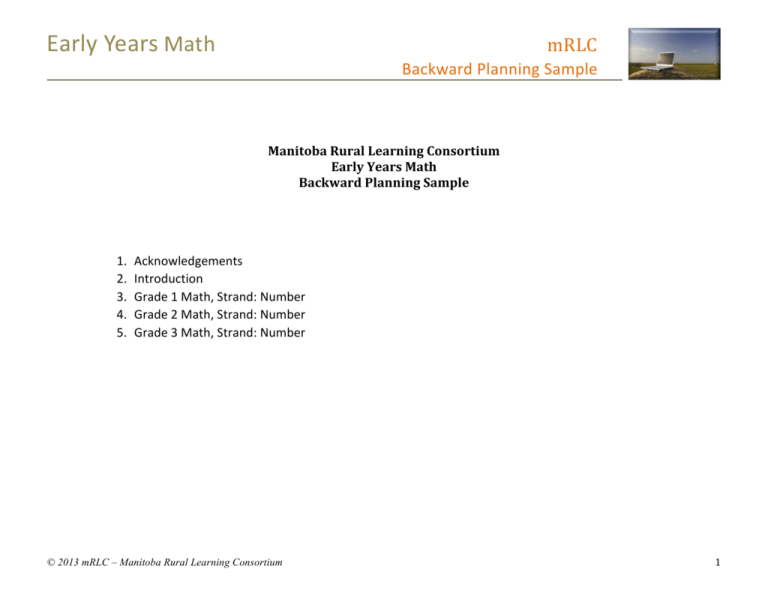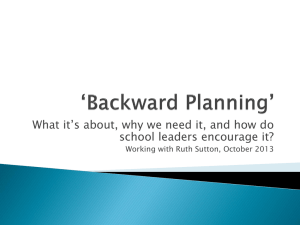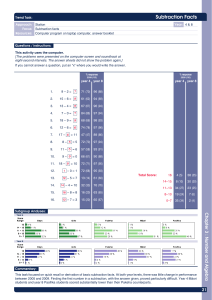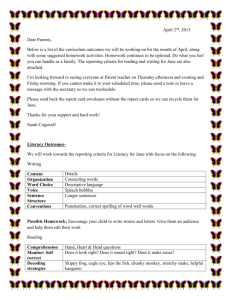Grade 1 Mathematics - Manitoba Rural Learning Consortium
advertisement

Early&Years!Math!! ! ! ! ! !!!!!! ! ! ! ! ! ! ! ! !!! ! ! !!mRLC! !! !!!!!!!!!!!!!!!Backward(Planning(Sample! " Manitoba(Rural(Learning(Consortium( Early(Years(Math( Backward(Planning(Sample( " " ! ! ! ! ! ! ! ! ! ! ! 1. 2. 3. 4. 5. Acknowledgements! Introduction! Grade!1!Math,!Strand:!Number! Grade!2!Math,!Strand:!Number! Grade!3!Math,!Strand:!Number! ! ! ! © 2013 mRLC – Manitoba Rural Learning Consortium 1" ! ! ( ( ( Manitoba(Rural(Learning(Consortium( Early(Years(Math( Backward(Planning(Sample( ( ( Early!Years!teachers!from!across!rural!Manitoba!have!developed!this!document.!The!mRLC!Early!Years!Math!Backward!Planning!Cohort!was!made!up!of!the! following!members:! ! ! ! ! ! ! ! ! ! ! ! ! ! ! ! ! ! ! ! ! Janice!Hamilton!!!!!!!! ! Lois!Mauthe!!!!!!!!!!! ! Stephanie!Hildebrand!!!!!!!!!!!! Tabitha!Johannesson!!!!!!!!!!!!! Amber!Bieganski!!!!!!!!!!!!!! Natalie!Hlady! ! ! Andrea!Maxwell! ! Connie!Johnson!! ! Tara!Reimer! ! ! Trish!Goosen! ! ! Allan!Stevenson!! ! Kim!Koop! ! ! © 2013 mRLC – Manitoba Rural Learning Consortium ! ! ! ! ! ! ! ! ! ! ! ! Prairie!Spirit! Pine!Creek! Garden!Valley! Evergreen! Whiteshell!! Sunrise! Sunrise! Hanover! Hanover! Lord!Selkirk! Sunrise! mRLC!Facilitator! 2" Introduction This draft document is intended to support teams of Early Years teachers in planning, teaching, assessing, and reporting on their Math programs. Teams of rural teachers developed the backward planning samples you see here. They used the mRLC Essential Learning and backward planning templates, the Manitoba Curriculum, and other related resources. The mRLC Essential Learning and backward planning templates helped teachers summarize and plan around important ideas and core processes that are central to the discipline and that have lasting value beyond the classroom. This sample material includes: • • • • • • a backwards plan template (that was used with the corresponding mRLC Essential Learning template) an outcome based grade book page a common assessment (s) samples of student work and rubrics based on a the report scale of 1-4 black line masters (where applicable) a list of resources mRLC believes that a collaborative planning process using mRLC Essential Learning documents and backward planning is key in developing teachers’ knowledge, expertise and professional competencies. This in turn improves student engagement and learning. mRLC Essential Learning and backward planning documents challenge the status quo of those existing planning, teaching and assessment practices that are often done in isolation with little regard given to such questions as, • • • • “Why is this important to teach in the first place?” “What are the essential skills, 21st century values and dispositions that must be imparted to students through this course of study?” “ How can this be accomplished in an engaging and creative way that will capture all students’ interest and talents?” “ What and how will evidence be collected to determine what students know, have learned, or have yet to learn?” Backward Planning captures the important ideas and core processes that are central to the discipline, it allows for a 21st century lens and the integration of provincial initiatives such as student engagement, social justice, sustainable development…. mRLC believes teachers will best acquire these skills together, overtime - learning constructively with “ an expert” guiding the process. This is work that requires deep thinking, time and practice to get it right. mRLC thinks this is time well spent. The value is in the doing. If the planning process is rigorous and thoughtful all students will be well served. It will take multiple years for teachers to master the backward planning process. It’s a process that will fundamentally impact every level of learning and teaching. Divisions that embark on supporting a backward planning process will, overtime, create a professional culture where standards and experience are shared as a way of doing business. They will have cultivated a level of professional practices that will have a huge impact on student learning. What we do know is that shift takes multiple years and requires a lot of guided professional practice, trail, error, reflection, collegiality and administrative support to accomplish. © 2013 mRLC – Manitoba Rural Learning Consortium 3" Teachers are expected to design plans that create engaging 21st century learning environments for their students - environments that are inquiry based, collaborative and problem solving in nature and that use important ideas – this being the case then it is incumbent that professional development experiences provide 21st learning environments for teachers. How else will they be able to duplicate this in their classrooms? These backward plans can serve as a testament to a process that engages groups of teachers in a collaborative process of designing engaging and rigorous 21st century learning and assessment opportunities for students. It is important to note that the attached templates are intended to serve as an example of how teachers might plan using essential learning and backward planning. The document should be used alongside the Manitoba Curriculum Framework of Outcomes for Math, as well as the grade-specific support documents. In addition, teachers are encouraged to consider the following issue: • Although the templates have been organized by specific strands of the Math curriculum, the overall program is intended to be presented as a spiral curriculum using a planning approach that is interwoven and explored throughout the year and over multiple years. What is backward planning? Backward planning is a method of designing curriculum"so that the curriculums’ intention is realized. Setting goals before choosing instructional methods and forms of assessment"breathes"life"into"the"curriculum. Backward planning of curriculum involves three stages: • • • Identify the results desired Determine acceptable levels of evidence that the desired results have occurred Design activities that will make desired results happen Backward planning challenges "traditional" methods of curriculum planning. In traditional curriculum planning, a list of content that will be taught is created and/or selected. In backward planning, the educators starts with goals, creates or plans out assessments and finally makes lesson plans. Backward planning process is like using a "road map". In this case, the destination is chosen first and then the road map is used to plan the trip to the desired destination. In contrast, in traditional curriculum planning there is no formal destination identified before the journey begins. The idea in backward planning is to teach toward the "end point" or learning goals, which typically ensures that the content taught remains focused and organized. This, in turn, aims at promoting better understanding of the content or processes to be learned by students. The teacher is able to focus on addressing what the students need to learn, what data can be collected to show that the students have learned the desired outcomes and how to ensure the students will learn. (Wiggins, McTighe) What mRLC teachers are saying about backward planning…. • • • • “ It’s extremely beneficial having the opportunity to collaborate with colleagues. This was awesome professional development and it gave me great insight and ideas.” “I grew as a professional. I made new contacts. I have shared learning with the grade groups in my school and division. I got another chance to use backward design.” “ I taught our draft unit and the growth was significant for my students and myself!” “ Enhanced clarity and consistency in instruction and assessment, the development of exemplars for each grade scale of the new provincial report card sets a consistent standard.” © 2013 mRLC – Manitoba Rural Learning Consortium 4" " Grade&1!Mathematics*! ! " " " " " " " " ! " ! " ! " ! " ! " ! " ! !! !Strand!! """"""" """"" Number! " ! " Table(of(Contents( 1. Backward!Planning!Sample!Template! ! 2. Grade!Book!Sample! ! ! ! ! ! ! 3. Assessments! Pre!Assessments:!! All!the!facts!with!Student!Samples! ! Strategy!Sort!with!Student!Samples! ! Number!Web!with!Student!Samples! ! Common!Assessments:! ! Tariq!and!the!Horses!with!Student!Samples! ! Fact!Family!Story!Problem!with!Student!Samples! People!on!the!Bus!with!Student!Samples!!!!!!! ! Create!your!own!Story!Problem!with!Student!Samples! ! Math!Problem!of!the!Day!with!Student!Samples! 10!Facts!!Count!on!1!More!!Make!a!10!with!Student!Samples! 10!Facts!!Count!Back!1!Less!!Use!Doubles!with!Student!Samples! 4. Black!Line!Masters! Fact!Families! Doubles! More!Fact!Families! ! ! ! ! ! ! ! © 2013 mRLC – Manitoba Rural Learning Consortium 5" " Grade(1( Strand:(Number( Backward(Planning(Sample(Template( Stage(One:(Identify(Desired(Learning( What%aspect%of%the%strand/unit%are%you%focusing%on%in%this%plan?%% ! ! ! ! ! ! Mathematical(Processes( Communication!(C)! Connections!(CN)! Reasoning!(R)! Technology!(T)! Visualization!(V)! Problem!Solving!(PS)! Mental!Math!and!Estimation!(ME)! 1.N.9!and!1.N.10! ""1.N.9."Demonstrate"an"understanding"of"addition"of"numbers"with"answers"to"20"and"their"corresponding"subtraction"facts,"concretely,"pictorially," and"symbolically,"by" • • • Using familiar and mathematical language to describe additive and subtractive actions from their experience Creating and solving problems in context that involve addition and subtraction Modeling addition and subtraction using a variety of cornet and visual representations, and recording the process symbolically """""""(C,"CN,"ME,"PS,"R,"T,"V)" 1.N.10."Describe"and"use"mental"mathematics"strategies"including" • • • • • Counting on, counting back Using one more, one less Making ten Starting from known doubles Using addition to subtract to determine basic addition and related subtraction facts to 18 """""""(C,"CN,"ME,"PS,"R,"T,"V)" © 2013 mRLC – Manitoba Rural Learning Consortium 6" Key Vocabulary: Operations: addition, add, sum, total, more, subtract, subtraction, difference, less, story problem, fact. Strategies: counting on, counting back, one more, one less, making 10, doubles, addition fact, subtraction fact Enduring!Understanding:! Essential!Questions:! 1. How!can!mental!math!strategies!enable!me!to!become!an! efficient!mathematician!in!my!world?! 2. (How!are!mental!math!strategies!going!to!make!math!easier! for!me?)! 3. How!can!being!able!to!solve!addition!and!subtraction! problems!affect!my!quality!of!daily!life?! 4. (How!can!solving!problems!help!me!make!decisions?)! Students!will!know!and!understand!how!to!take!apart!and!put!together! quantities!and!understand!that!addition!and!subtraction!are!inverse! operations.! Students!will!know….! • Students will know and understand how to take apart and put together quantities and understand that addition and subtraction are inverse operations. " Students!will!be!able!to…! • • • • • • • • • • Students will answer addition and subtraction questions to 20, concretely, pictorially, and symbolically Facts to 18: making doubles, making 10’s, start from known doubles using addition and subtraction Use familiar and mathematical language to describe additive and subtractive actions from their experience Create and solve problems in context that involve addition and subtraction Describe and use the following mental math strategies counting on and counting back Using one more and one less Making ten Starting from known doubles Using addition to subtract To determine the basic addition and related subtraction facts to 18 Recall of one more and one less, complementary (compatible numbers) that adds up to 5 and 10, doubles (5+5), and that are related subtraction facts is expected by the end of grade one. " © 2013 mRLC – Manitoba Rural Learning Consortium 7" " Grade(1(( Strand:(Number( Stage(Two:(Determine(Acceptable(Evidence( Address the questions through these assessments … Formative( Summative( Pre!AssessmentZ! Write! ! ! " • • • • All!the!facts! PartZPart!Whole!Dot!Flash!Cards! Strategy!Sort! Number!web! • • • Write!and!solve!your!own!addition!word!problem.!Show!your! answer!pictorially!and!using!a!number!sentence.!Prove!your! answer!using!subtraction.!! How!Many!Ways! All!the!Facts! ! Say! ! Verbally!explain!the!strategy!you!used.! ! Do! ! • Show!how!you!got!your!answer!using!manipulatives.!i.e.!Base! Ten!Blocks,!Manipualtives!etc.!BLM!1.N.9!and!10.1!(gr.1!support! document)! " " " " © 2013 mRLC – Manitoba Rural Learning Consortium 8" " " What are the performance indicators? Report Card Categories Knowledge and Understanding Questions How can I take apart and put together quantities? Level 1 Has difficulty... Level 2 Needs some support... Mental Math and Estimation How can I take apart and put together quantities using mental math strategies? Has difficulty... Needs some support... Problem Solving How can I create and solve problems using addition and subtraction? Has difficulty.... Needs some support... Level 3 Level 4 Usually arrives at an accurate solution... Consistently and independently demonstrates an understanding of addition of numbers with answers to and their corresponding subtraction facts, concretely, pictorally and symbolically. Usually arrives at an accurate solution... Consistently and independently finds the sum and differences for quantities to 20(concretely, pictorally and symbolically) using: doubles, making 10,one more, one less, starting from a known double and using addition to solve subtraction Usually arrives at an accurate solution... Consistently and independently creates and solves problems in context that involve addition and subtraction " " " " " " © 2013 mRLC – Manitoba Rural Learning Consortium 9" " Grade(1( Strand:(Number( Stage(Three:(Plan(Learning(Experiences( Learning%Sequence:! Activate:!Shake!SSpill!and!Record!(partZpart!whole!activity)!Put!10!twoZsided!coins/beans!in!a!container.!!Spill!onto!table.!!Have!students!sort!them!into!the! two!groups.!!(i.e.!white!and!red).!!Record!the!number!sentences!as!a!class.!!Do!this!several!times.!!Discuss!any!patterns!they!see.!!ReZdo!the!activity!with!a! different!number!of!counters!and!models.!(ie.!ten!frames,!dot!cards,!etc.)!!!What!do!students!notice?! Acquire:!Use!a!real!life!problem.!!I!have!10!cookies.!!I!have!to!share!some!with!my!dad.!!!I!do!not!have!to!share!them!fairly.!!What!are!the!different!ways!I! could!share!them!with!him?!!Draw!and!share!your!answer.!!RoleZplaying!it!is!an!option!as!well.!!As!a!class,!discuss!the!different!possible!answers!and!why! they!each!work!or!don't!work.! Play!"Power!of!Ten"!games!such!as!"Power!of!10",!"Power!of!9"!and!"Power!of!8"!!(Trevor!Calkins!resource)! Build!number!trains!to!represent!different!number!combinations!to!represent!i.e.!7.!(See!Grade!1!support!document!for!BLM's!for!students!to!record!their! work!in!different!colors.)!!Record!fact!families!for!these!trains!symbolically.! Fact!Sorts!and!Number!webs!to!discuss!how!different!students!would!solve!different!facts!(purpose!Z!to!discuss!and!name!strategies/common!vocabulary.)!! Suggestion!to!create!a!bulletin!board!of!facts!and!strategies!used.!! Use!various!Greg!Tang!stories!to!have!students!share!how!they've!determined!the!number!of!objects!in!an!illustration.! ! Apply:!!Provide!students!with!word!problems!to!solve.!!Then!students!create!and!solve!their!own!problems.!!(See!page!45!of!Grade!1!Math!Support! Document!to!be!sure!a!variety!of!different!kinds!of!word!problems!are!used!with!students!throughout!the!year.)!!! Note:!!These!lessons!are!a!series!of!lessons!that!are!meant!to!be!taught!repetitively!throughout!the!year,!varying!the!manipulatives!being!used!and!the! complexity!of!the!numbers.!!Both!subtraction!and!addition!should!not!be!taught!exclusively!alone.! Resources:!! Mathematics!Support!Document!Z!gr.1! Power&of&Ten&Trevor&Calkins& Teaching&Student&Centered&Mathematics&Grades&KZ3!John!A.!Van!de!Walle! Hands&on&Problem&Solving&Jennifer&Lawson& © 2013 mRLC – Manitoba Rural Learning Consortium 10" " Sample Grade Book Grade One Math Strand: Number 4 Very good understanding 3 Good understanding 2 Basic understanding 1 Limited understanding ND Not yet demonstrated Enduring Understanding: Students will know and understand how to take apart and put together quantities and understand that addition and subtraction are inverse operations. " Report Card Categories Knowledge and Understanding Essential Question How can I take apart and put together quantities? Mental Math and Estimation Essential Question How can I take apart and put together quantities using mental math strategies? Evidence from Assessments Using Ten Frame(s) # web Problem Solving Essential Question How can I create and solve problems using addition and subtraction? Evidence from Assessments Strategy Sort All the Facts (addition) Evidence from Assessments All the Facts (subtract.) Represent/ solve an addition story problem pictorially or symbolically Represent/ solve a subtraction story problem pictorially or symbolically Create and Solve a story problem (addition) Create a word problem for a given fact family Students " " " " " " " " " " " " " " " " " " " " " " " " " " " " " " " " " " " " " " " " " " " " " " " " " " " " " " " " " " " " " " " " " © 2013 mRLC – Manitoba Rural Learning Consortium 11" " © 2013 mRLC – Manitoba Rural Learning Consortium 12"




